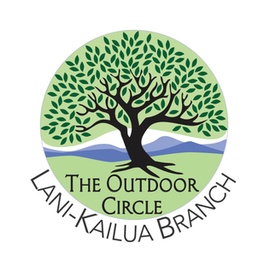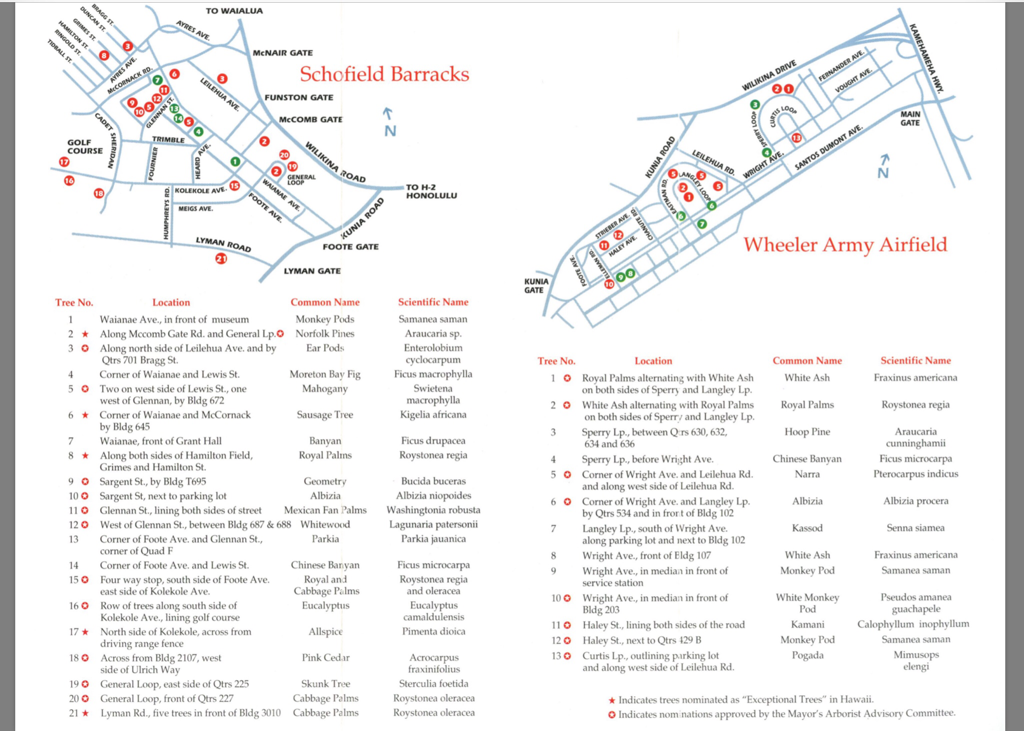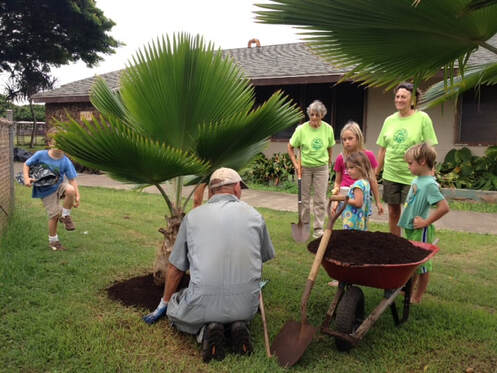Trees
Protecting, Preserving, and
Planting for the Future
On this page, click on the following links to find:
~ Kailua Citizen Forester Project
~ LKOC Tree Appreciation Project
~ Exceptional Trees in Kailua
~ How The Outdoor Circle Helps Maintain our Urban Tree Canopy
~ Honolulu’s Diminishing Urban Tree Canopy and Initiatives To Address It
~ Educational Outreach: Exceptional Tree Tour at Schofield and Wheeler
~ Educational Outreach: Kailua Recreation Center Tree Mulching Day
~ Educational Outreach: Teaching The Next Generation About the Importance of Trees
We also invite you to click on the following links to visit these pages:
~ Beautification Projects: Highlights of LKOC Beautification Projects since 1948,
including a Video and Interactive Site Map
~ Helpful Resources: Useful information about trees and plants
~ LKOC History: History of LKOC Environmental Stewardship since our founding in 1948
~ TOC Stewardship: Highlights of TOC Environmental Stewardship since 1912, including
a Video of TOC's Tree Planting Projects Statewide,
a Video of TOC's Environmental Stewardship Statewide,
and Interactive Site Map of TOC's Environmental Stewardship in Urban Honolulu
~ Kailua Citizen Forester Project
~ LKOC Tree Appreciation Project
~ Exceptional Trees in Kailua
~ How The Outdoor Circle Helps Maintain our Urban Tree Canopy
~ Honolulu’s Diminishing Urban Tree Canopy and Initiatives To Address It
~ Educational Outreach: Exceptional Tree Tour at Schofield and Wheeler
~ Educational Outreach: Kailua Recreation Center Tree Mulching Day
~ Educational Outreach: Teaching The Next Generation About the Importance of Trees
We also invite you to click on the following links to visit these pages:
~ Beautification Projects: Highlights of LKOC Beautification Projects since 1948,
including a Video and Interactive Site Map
~ Helpful Resources: Useful information about trees and plants
~ LKOC History: History of LKOC Environmental Stewardship since our founding in 1948
~ TOC Stewardship: Highlights of TOC Environmental Stewardship since 1912, including
a Video of TOC's Tree Planting Projects Statewide,
a Video of TOC's Environmental Stewardship Statewide,
and Interactive Site Map of TOC's Environmental Stewardship in Urban Honolulu
The Kailua Citizen Forester Project
Team of Citizen Foresters in Kailua
In order to determine whether our islands have the recommended tree canopy to keep our islands healthy, the City and County of Honolulu, Department of Land and Natural Resources - Kaulunani, Smart Trees Pacific, the University of Hawaii and The Outdoor Circle have been conducting a census of trees. The program started with volunteers in Kailua.
In June 2016, a group of passionate volunteers began their training to become “certified citizen foresters” (CFs). With the help and support of arborists and mapping specialists, these volunteers learned how to ID trees, gather metrics such as height, canopy spread and diameter and input all of this data into an online GIS software system called "Tree Plotter." Since completion of the training sessions at the end of July 2016, these citizen foresters have met once per week in order to map all of Kailua’s street trees. As of December 2016, they had mapped over 1,300 trees and are quickly approaching their goal of recording data for every street tree in the Kailua.
Check Out the Tree Mapping Progress in Kailua for Yourself!
The accumulated data is available to the general public through an interactive map, where you can see the trees, and their associated metrics, including the calculated environmental and monetary benefits they provide annually.
Click here to view the tree plotter map for Kailua.
In June 2016, a group of passionate volunteers began their training to become “certified citizen foresters” (CFs). With the help and support of arborists and mapping specialists, these volunteers learned how to ID trees, gather metrics such as height, canopy spread and diameter and input all of this data into an online GIS software system called "Tree Plotter." Since completion of the training sessions at the end of July 2016, these citizen foresters have met once per week in order to map all of Kailua’s street trees. As of December 2016, they had mapped over 1,300 trees and are quickly approaching their goal of recording data for every street tree in the Kailua.
Check Out the Tree Mapping Progress in Kailua for Yourself!
The accumulated data is available to the general public through an interactive map, where you can see the trees, and their associated metrics, including the calculated environmental and monetary benefits they provide annually.
Click here to view the tree plotter map for Kailua.
LKOC’s Tree Appreciation Project ~ Thank You Tree Keepers!
We’d love to hear from you about trees you appreciate!
A beautiful Helioptrope on Kainalu Drive
As more homeowners are building homes that cover more of their land, and paving even more, we are losing the tree canopy scientists say we need to sustain healthy communities. In addition to the shade and oxygen trees provide, they help deaden the noise of crowded streets, cool our roofs and asphalt, and promote a feeling of peace and well-being in our neighborhoods.
We have all experienced seeing trees removed and the feeling of loss that brings. It’s possible that if the owners knew the community valued their tree, they might have found a way to work around the tree.
If there is a tree you appreciate, please help us let the owners know. We will write the owners a letter letting them know someone asked us to thank them for supporting our community by keeping the tree.
You can send us an e-mail by clicking *HERE* telling us the address of where the tree is. If you can, please include a sentence or two about why you appreciate the tree, and we will pass on those comments.
Your nomination will be kept anonymous, and we will determine who the property owner is, and let them know that others appreciate what they are doing to keep Kailua clean, green, and beautiful!
And if you have a special tree story to share, which we may feature on our social media platforms, we’d love to hear from you, too! Email us at: [email protected]
We have all experienced seeing trees removed and the feeling of loss that brings. It’s possible that if the owners knew the community valued their tree, they might have found a way to work around the tree.
If there is a tree you appreciate, please help us let the owners know. We will write the owners a letter letting them know someone asked us to thank them for supporting our community by keeping the tree.
You can send us an e-mail by clicking *HERE* telling us the address of where the tree is. If you can, please include a sentence or two about why you appreciate the tree, and we will pass on those comments.
Your nomination will be kept anonymous, and we will determine who the property owner is, and let them know that others appreciate what they are doing to keep Kailua clean, green, and beautiful!
And if you have a special tree story to share, which we may feature on our social media platforms, we’d love to hear from you, too! Email us at: [email protected]
Exceptional Trees in Kailua
Exceptional Morton Bay Fig and Chinese Banyan at Kailua Central Triangle
LKOC was instrumental in getting several trees on public property in Kailua ‘exceptionalized”. An Exceptional Tree is one recognized by the State of Hawaii as special and deserving of care and protection. These trees contribute greatly to our urban canopy, providing shade, cooling, health benefits, and beauty. The State Exceptional Tree Act (enacted in 1975) was spearheaded by the Outdoor Circle.
Four trees in the Central Triangle of Kailua were exceptionalized by LKOC in the early 2000s. These include three Chinese Banyans and a Morton Bay Fig, pictured above. These trees provide a stunning focal point as you enter the Kailua business district.
Three spectacular Monkey pod specimens on the grounds of Women’s Community Correctional Center were exceptionalized by LKOC in 2002. These majestic trees, which are clearly visible from Kalaniana’ole Highway, attract visitors and residents alike. In exchange for WCCC's agreement to allow them deemed 'exceptional', LKOC committed to pay for their pruning and maintenance, as our contribution to our community. Since 2004, LKOC has spent well over $33,000 to date, on their professional trimming every few years.
Four trees in the Central Triangle of Kailua were exceptionalized by LKOC in the early 2000s. These include three Chinese Banyans and a Morton Bay Fig, pictured above. These trees provide a stunning focal point as you enter the Kailua business district.
Three spectacular Monkey pod specimens on the grounds of Women’s Community Correctional Center were exceptionalized by LKOC in 2002. These majestic trees, which are clearly visible from Kalaniana’ole Highway, attract visitors and residents alike. In exchange for WCCC's agreement to allow them deemed 'exceptional', LKOC committed to pay for their pruning and maintenance, as our contribution to our community. Since 2004, LKOC has spent well over $33,000 to date, on their professional trimming every few years.
Exceptional Monkeypod at Women’s Community Correctional Center
To see a map of all Exceptional Trees in the State, please visit The Outdoor Circle’s interactive Exceptional Tree map.
To see an article about the Exceptional Trees at WCCC, and LKOC’s history of caring for them, click on the link below.
https://midweek.com/pdf/Windward/2021/0317/index2.html#p=4
To see an article about the Exceptional Trees at WCCC, and LKOC’s history of caring for them, click on the link below.
https://midweek.com/pdf/Windward/2021/0317/index2.html#p=4
Exceptional Trees At Schofield Barracks and Wheeler Army Airfield
In the fall of 2016, LKOC sponsored a tour of the Exceptional Trees at Schofield Barracks and Wheeler Army Airfield in Waipahu. These facilities are home to the largest collection of Exceptional Trees in the Islands, many of which were planted by the Outdoor Circle back in the 1930's and 40's. Our tour guides were noted arborist Steve Nimz, and the Director of Public Works at the facilities, Patrick Ching. It was a fascinating day, and we are so appreciative of the care these two have taken to preserve these trees, despite the ever growing expansion and renovation going at the bases over the years.
Pictured below, our tour group hears about this magnificent monkeypod, with a span of over 80 feet, the first one planted at Schofield.
Pictured below, our tour group hears about this magnificent monkeypod, with a span of over 80 feet, the first one planted at Schofield.
Here is an informative brochure showing many of the Exceptional Trees on our tour, with reference to The Outdoor Circle’s contribution to their planting.
ARBOR DAY TREE MULCHING AT KAILUA RECREATION CENTER
For Arbor Day, 2013, LKOC held a mulching day at the Kailua Recreation Center, where volunteers mulched over fifty trees on the property. It was an educational event as well, where our keiki and kupuna learned the value of mulching, as well as techniques on how to do it properly, from landscape expert (and Lan-Kailua Outdoor Circle Beautification Chair, and past Outdoor Circle President) Steve Mechler.
EDUCATIONAL OUTREACH IN SCHOOLS
In November 2019, LKOC volunteers, Diane Harding and Steve Mechler, visited the 3- and 4-year-olds at St. Mark’s Lutheran Preschool in Kaneohe. They introduced the children to the coloring book, "Trees of Hawaii", which contains delightful line drawings of some of the trees found in Hawaii. Each drawing is accompanied by a description of why the tree is significant to Hawaii. The trees depicted are ohia, hala, kukui, monkey pod, coconut palm, lo’ulu palm, plumeria, papaya, and gold tree. Each child received a gift copy to take home. The "Trees of Hawaii" coloring books are available to purchase on our LKOC Store page.
For decades, LKOC has been periodically visiting Preschools and Elementary Schools on the Windward side, to promote stewardship and tree appreciation.
For decades, LKOC has been periodically visiting Preschools and Elementary Schools on the Windward side, to promote stewardship and tree appreciation.
The Outdoor Circle has a simple mission statement of “Keeping Hawaii clean, green and beautiful”, but what we do is extremely complicated, and cannot be explained quickly and easily.
We plant trees, but we are so much more than a tree-planting organization. We have historical records showing our founders going by horseback up into the foothills to re-forest the hillsides. The situation is much different now. It is difficult to plant a tree today without going through a complicated process. Still, we advocate planting trees and will work to plant them anywhere we can.
We’re not the only organization that plants trees. But just putting a tree in the ground doesn’t reforest anything. Maintaining our forests, urban and rural, as a healthy environment, takes years of attention. The Outdoor Circle didn’t just exist for over 100 years, we were involved with our community in ways that have impacted Hawaii for good that would not have been done by any other organizations, however wonderful they are.
The Outdoor Circle doesn’t plant and run. We follow up for decades, advocating for trees and the benefits they contribute. Our organization and its many branches care for forests, planted areas, open areas—all the way down to individual trees: tree by tree, area by area, island by island. When a tree is sickly or butchered, we work for the health of that tree. When a tree is in danger of being removed, we work to keep it.
Because the public is not as knowledgeable about trees and who to turn to in order to protect them, we have been given a mandate from them to protect trees and green spaces. Members of the public expect us to keep Hawaii beautiful and fault the Outdoor Circle publicly if standards are not met.
This kind of advocacy requires a great expenditure of time and knowledge. Experience shows there is background that needs to be understood for every incidence. Is the tree a responsibility of the state or the county? Does it come under Department of Transportation or Parks and Recreation? Is work being done by a government crew or a contractor? Who is the certified arborist overseeing the work? Who determines whether or not a tree might create a danger? And, we make sure all this knowledge is at hand, 24 hours a day, because the crew is maiming or removing the tree as we go through this maze of information. We’ve done such a good job, that much of the public takes it for granted that we will be there.
We plant trees, but we are so much more than a tree-planting organization. We have historical records showing our founders going by horseback up into the foothills to re-forest the hillsides. The situation is much different now. It is difficult to plant a tree today without going through a complicated process. Still, we advocate planting trees and will work to plant them anywhere we can.
We’re not the only organization that plants trees. But just putting a tree in the ground doesn’t reforest anything. Maintaining our forests, urban and rural, as a healthy environment, takes years of attention. The Outdoor Circle didn’t just exist for over 100 years, we were involved with our community in ways that have impacted Hawaii for good that would not have been done by any other organizations, however wonderful they are.
The Outdoor Circle doesn’t plant and run. We follow up for decades, advocating for trees and the benefits they contribute. Our organization and its many branches care for forests, planted areas, open areas—all the way down to individual trees: tree by tree, area by area, island by island. When a tree is sickly or butchered, we work for the health of that tree. When a tree is in danger of being removed, we work to keep it.
Because the public is not as knowledgeable about trees and who to turn to in order to protect them, we have been given a mandate from them to protect trees and green spaces. Members of the public expect us to keep Hawaii beautiful and fault the Outdoor Circle publicly if standards are not met.
This kind of advocacy requires a great expenditure of time and knowledge. Experience shows there is background that needs to be understood for every incidence. Is the tree a responsibility of the state or the county? Does it come under Department of Transportation or Parks and Recreation? Is work being done by a government crew or a contractor? Who is the certified arborist overseeing the work? Who determines whether or not a tree might create a danger? And, we make sure all this knowledge is at hand, 24 hours a day, because the crew is maiming or removing the tree as we go through this maze of information. We’ve done such a good job, that much of the public takes it for granted that we will be there.










